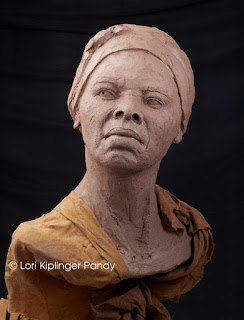Here is an update on Harriet's progress. I let her rest over the weekend after having hollowed her out. She was a bit over-dry when I checked this morning, so I've soaked some cloth to drape over the driest parts and misted well before beginning work again.
I can see I've got to work on the symmetry a bit more, but she is making progress. I intend for the surface to retain a lot of looseness and energy, so the challenge will be to bring it to a level of completion that pleases me and stopping before I overwork her. Estimated time to date: 5 hours.
Monday, November 7, 2011
Thursday, November 3, 2011
Hollowing out a ceramci portrait bust
One of the things that must happen when working in ceramic, or water-based clay, is that the piece must be hollow before firing. I find that many times when I'm working on a piece, the clay tends to shift or perhaps I change the angle of the neck or something to create more tension or drama.
The results are that the piece can become very thick in some areas and fragile and thin in others. This was the case with my Harriet Tubman bust. The addition of all the clay to the back of her head holding her scarf was pulling on the sculpt and I was supporting it with wood while it stiffened up.
At the same time, the neck area near the clavicle was quite thin.
So, although this piece wasn't at the leather-hard stage, I decided to do a preliminary hollowing early. The clay is still very soft and wet, so very easily distorted. First, I took my wire tool and cult through the sculpt. Then I removed the newspaper that I already
had in there.It was easy to see just how thin parts of the neck here - it was clear that it would have been fragile to continue to sculpt. After I separated the two halves, I lead them on foam covered with plastic to cushion it pieces. Next, I used a wire loop and tool and carved out the excess clay. Thin areas, I built back up to make stronger.
Finally, I took a fork and poked holes throughout both halves, to reduce the change for air pockets and to facilitate even drying. Then scored both edges, added slip and filled the head cavity with shredded paper and reassembled the two pieces. I added the paper into the head because the sculpt is still quite wet and will be prone to distortion. I can remove it later through the opening at the bottom of the neck. After the clay rests a bit, I will continue with the sculpting.
The results are that the piece can become very thick in some areas and fragile and thin in others. This was the case with my Harriet Tubman bust. The addition of all the clay to the back of her head holding her scarf was pulling on the sculpt and I was supporting it with wood while it stiffened up.
At the same time, the neck area near the clavicle was quite thin.
So, although this piece wasn't at the leather-hard stage, I decided to do a preliminary hollowing early. The clay is still very soft and wet, so very easily distorted. First, I took my wire tool and cult through the sculpt. Then I removed the newspaper that I already
had in there.It was easy to see just how thin parts of the neck here - it was clear that it would have been fragile to continue to sculpt. After I separated the two halves, I lead them on foam covered with plastic to cushion it pieces. Next, I used a wire loop and tool and carved out the excess clay. Thin areas, I built back up to make stronger.
Finally, I took a fork and poked holes throughout both halves, to reduce the change for air pockets and to facilitate even drying. Then scored both edges, added slip and filled the head cavity with shredded paper and reassembled the two pieces. I added the paper into the head because the sculpt is still quite wet and will be prone to distortion. I can remove it later through the opening at the bottom of the neck. After the clay rests a bit, I will continue with the sculpting.
Subscribe to:
Posts (Atom)




